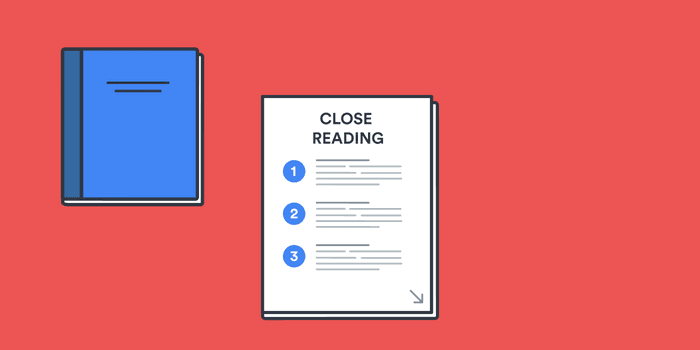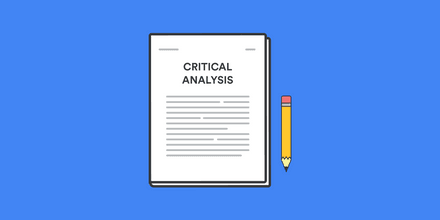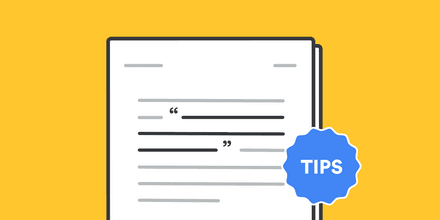
Close reading refers to the process of interpreting a literary work’s meaning by analyzing both its form and content. In this post, we provide you with strategies for close reading that you can apply to your next assignment or analysis.
What is a close reading?
Close reading involves paying attention to a literary work’s language, style, and overall meaning. It includes looking for patterns, repetitions, oddities, and other significant features of a text. Your goal should be to reveal subtleties and complexities beyond an initial reading.
The primary difference between simply reading a work and doing a close reading is that, in the latter, you approach the text as a kind of detective.
When you’re doing a close reading, a literary work becomes a puzzle. And, as a reader, your job is to pull all the pieces together—both what the text says and how it says it.
How do you do a close reading?
Typically, a close reading focuses on a small passage or section of a literary work. Although you should always consider how the selection you’re analyzing fits into the work as a whole, it’s generally not necessary to include lengthy summaries or overviews in a close reading.
There are several aspects of the text to consider in a close reading:
- Literal Content: Even though a close reading should go beyond an analysis of a text’s literal content, every reading should start there. You need to have a firm grasp of the foundational content of a passage before you can analyze it closely. Use the common journalistic questions (Who? What? When? Where? Why?) to establish the basics like plot, character, and setting.
- Tone: What is the tone of the passage you’re examining? How does the tone influence the entire passage? Is it serious, comic, ironic, or something else?
- Characterization: What do you learn about specific characters from the passage? Who is the narrator or speaker? Watch out for language that reveals the motives and feelings of particular characters.
- Structure: What kind of structure does the work utilize? If it’s a poem, is it written in free or blank verse? If you’re working with a novel, does the structure deviate from certain conventions, like straightforward plot or realism? Does the form contribute to the overall meaning?
- Figurative Language: Examine the passage carefully for similes, metaphors, and other types of figurative language. Are there repetitions of certain figures or patterns of opposition? Do certain words or phrases stand in for larger issues?
- Diction: Diction means word choice. You should look up any words that you don’t know in a dictionary and pay attention to the meanings and etymology of words. Never assume that you know a word’s meaning at first glance. Why might the author choose certain words over others?
- Style and Sound: Pay attention to the work’s style. Does the text utilize parallelism? Are there any instances of alliteration or other types of poetic sound? How do these stylistic features contribute to the passage’s overall meaning?
- Context: Consider how the passage you’re reading fits into the work as a whole. Also, does the text refer to historical or cultural information from the world outside of the text? Does the text reference other literary works?
Once you’ve considered the above features of the passage, reflect on its relationship to the work’s larger themes, ideas, and actions. In the end, a close reading allows you to expand your understanding of a text.
Close reading example
Let’s take a look at how this technique works by examining two stanzas from Lorine Niedecker’s poem, “I rose from marsh mud”:
I rose from marsh mud, algae, equisetum, willows, sweet green, noisy birds and frogs to see her wed in the rich rich silence of the church, the little white slave-girl in her diamond fronds.
First, we need to consider the stanzas’ literal content. In this case, the poem is about attending a wedding. Next, we should take note of the poem’s form: four-line stanzas, written in free verse.
From there, we need to look more closely at individual words and phrases. For instance, the first stanza discusses how the speaker “rose from marsh mud” and then lists items like “algae, equisetum, willows” and “sweet green,” all of which are plants. Could the speaker have been gardening before attending the wedding?
Now, juxtapose the first stanza with the second: the speaker leaves the natural world of mud and greenness for the “rich/ rich silence of the church.” Note the repetition of the word, “rich,” and how the poem goes on to describe the “little white slave-girl/ in her diamond fronds,” the necessarily “rich” jewelry that the bride wears at her wedding.
Niedecker’s description of the diamond jewelry as “fronds” refers back to the natural world of plants that the speaker left behind. Note also the similarities in sound between the “frogs” of the first stanza and the “fronds” of the second.
We might conclude from a comparison of the two stanzas that, while the “marsh mud” might be full of “noisy/ birds and frogs,” it’s a far better place to be than the “rich/rich silence of the church.”
Ultimately, even a short close reading of Niedecker’s poem reveals layers of meaning that enhance our understanding of the work’s overall message.
How to write a close reading essay
Getting started
Before you can write your close reading essay, you need to read the text that you plan to examine at least twice (but often more than that). Follow the above guidelines to break down your close reading into multiple parts.
Once you’ve read the text closely and made notes, you can then create a short outline for your essay. Determine how you want to approach to structure of your essay and keep in mind any specific requirements that your instructor may have for the assignment.
Structure and organization
Some close reading essays will simply analyze the text’s form and content without making a specific argument about the text. Other times, your instructor might want you to use a close reading to support an argument. In these cases, you’ll need to include a thesis statement in the introduction to your close reading essay.
You’ll organize your essay using the standard essay format. This includes an introduction, body paragraphs, and a conclusion. Most of your close reading will be in the body paragraphs.
Formatting and length
The formatting of your close reading essay will depend on what type of citation style that your assignment requires. If you’re writing a close reading for a composition or literature class, you’ll most likely use MLA or Chicago style.
The length of your essay will vary depending on your assignment guidelines and the length and complexity of the text that you’re analyzing. If your close reading is part of a longer paper, then it may only take up a few paragraphs.
Citations and bibliography
Since you will be quoting directly from the text in your close reading essay, you will need to have in-text, parenthetical citations for each quote. You will also need to include a full bibliographic reference for the text you’re analyzing in a bibliography or works cited page.
To save time, use a credible citation generator like BibGuru to create your in-text and bibliographic citations. You can also use our citation guides on MLA and Chicago to determine what you need to include in your citations.
Frequently Asked Questions about how to do a close reading
✴️ How do you do a close reading?
A successful close reading pays attention to both the form and content of a literary work. This includes: literal content, tone, characterization, structure, figurative language, diction, sound, style, and context.
♻️ What's a close reading essay?
A close reading essay is a paper that analyzes a text or a portion of a text. It considers both the form and content of the text. The specific format of your close reading essay will depend on your assignment guidelines.
✂️ What is the difference between skimming and close reading?
Skimming and close reading are opposite approaches. Skimming involves scanning a text superficially in order to glean the most important points, while close reading means analyzing the details of a text’s language, style, and overall form.
💈 How do you introduce a close reading?
You might begin a close reading by providing some context about the passage’s significance to the work as a whole. You could also briefly summarize the literal content of the section that you’re examining.
💎 How long should a close reading essay be?
The length of your essay will vary depending on your assignment guidelines and the length and complexity of the text that you’re analyzing.


